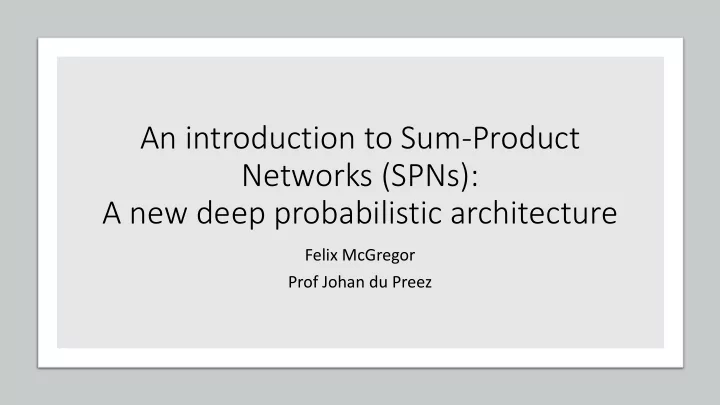

An introduction to Sum-Product Networks (SPNs): A new deep probabilistic architecture Felix McGregor Prof Johan du Preez
What are SPNs? • Poon and Domingos, (UAI 2011 Best Paper) • Acyclic directed graphs os sums and products
Two views of f SPNs 1. Deep architecture • Product node as activation function • Clear semantics • Reason meaningfully about relationships between variables as we are calculating probabilities with respect to some features
Bayesian Networks Two vie iews of f SPNs 2. Probabilistic graphical models • Tractable inference can calculate partition • Inference in linear time to the size of the Markov Random Fields network
Probabilistic inference • An SPN represents a joint distribution over a set of variables • P( 𝑌 1 = 1, 𝑌 2 = 0) ?
Marginal Inference • P( 𝑌 1 = 1) ?
MPE Inference • What is the most likely state?
Conditions for a valid SPN • Complete: children of sum are of the same scope (Mixtures of distributions) • Decomposable: children of a product node are of different scopes (Distributions that factorise)
What does this mean? Gens ICML 2013
Parameter estimation • Lends itself naturally to backpropagation • Vanishing gradient / gradient diffusion • “Hard” gradient DiMauro 2016
Parameter estimation Gens & Domingos 2012
Structure learning: LearnSPN Split variables on Cluster similar approximate instances independence
Cool applications: Face completion Poon & Domingos 2011
Cool applications • 83.96% on CIFAR 10 Discriminative Learning of Sum-Product Networks (NIPS 2012) • Satellite image classification
Resources • Best place for all things SPN • https://github.com/arranger1044/awesome-spn • Some video lecture sites • http://techtalks.tv/ • http://videolectures.net/ • My Github • https://github.com/felixmcgregor/Sum-Product-Networks
Recommend
More recommend